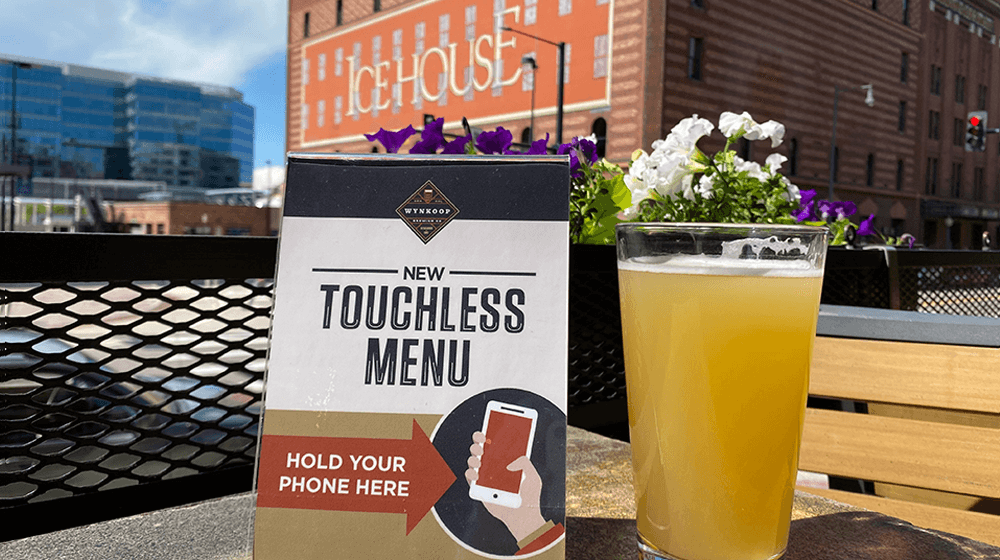
As lockdown restriction ease up and restaurants and eateries start to open, SpeedPro has released a new signage technology to help maintain social distancing for customers with touchless menus. The new SpeedPro InfoLnkX, allows diners to make orders using their phones instead of handheld menus for safer dining experiences.
InfoLnkX can be strategically positioned within a restaurant’s high-interaction customer touchpoints like host stands and dining tables. And all a customer needs to do is hold their phones up to the sign. It then opens the restaurant’s menu through the web browser on each guest’s mobile device.
SpeedPro InfoLnkX Touchless Menus
The smart signage technology uses Near Field Communication (NFC) and Quick Response code (QR Codes) to communicate with mobile devices. According to the developers, the touch-free smart signage technology has multiple applications that go beyond restaurants. Museums, retailers and other public attractions are some of the possible applications for InfoLnkX.
“We knew this touchless technology would change the customer experience. We were in the process of developing it prior to the pandemic and have expedited the tech’s launch in order to aid businesses in their reopening and social distancing efforts to provide a solution to critical need restaurants and other businesses face today”, said Larry Oberly SpeedPro’s CEO in an emailed press release.
Restaurants Dealing with New Rules
According to the company, the touchless menus will not only support social distancing among customers and staff but will lower restaurant overhead costs by reducing the number of menu reprints. The smart signages can also provide more than what can be printed on the display. Customers can be directed to website links, video files, audio files and other types of communication. This content can play a critical role in business and community safety.
The solution can help an added tier of security for eateries that have put in a business continuity plan. The smart technology can be used for large-format printing applications including banners, signs, acrylic, murals and other branding materials to integrate the in-person and online customer experience.
It essentially helps bridge the gap between in-person visual communication and online experience. This will provide additional information and flexibility with new products and services. In turn, it will expand marketing options by being able to reach the engaged audience through retargeting long after the in-person interaction. This will come handy in an era of heightened social distancing.
Even though the partnership with Breckenridge-Wynkoop Restaurant Group was in the works prior to the pandemic the launch was expedited as the need arose to help offer the solution for businesses. Furthermore, the service application can also help promote brands by facilitating the easy transition from awareness to engagement.
Using Technology to Confront Unexpected Setbacks
Being an agile business means being ready for any eventuality good or bad, especially during this difficult period. Looking at technology can play a crucial role in keeping businesses afloat. Through online shopping, cloud-based applications, contactless payment, remote working and virtual meetings have all helped businesses weather the storm. Technology has helped businesses accelerate changes in their operations to meet the challenges heads on.
The crisis has placed new demands on IT infrastructure, especially networks and data centers, as businesses went online and employees increasingly connect over the internet to corporate systems. Those fortunate to have some foresight not only integrated technology into their operations but also equipped their workforce with the skills to use these tools. This came in handy as work from home directives came into force.
Like all crises, they will show challenges and opportunities and, in this regard, the pandemic too helped businesses assess their digital readiness. It has helped businesses improvise and experiment on how they operate. Businesses are learning and progressing more quickly than ever before. Companies are looking at scenarios and rising up to the challenges to get better traction and agility. They are also holding frank conversations with their suppliers, regulators and customers to make the transition as painless as possible. They are learning to look more outwards besides their business and industry for risks.
COVID-19 has helped demonstrate the importance of digital readiness for businesses. It is forcing businesses to adapt to the changing dynamics and how they function. Business owners should look towards building tech-based infrastructure to support a digitized world, stay current and competitive.
READ MORE:
Image: SpeedPro
This article, “SpeedPro Releases New Touchless Menu Technology for Restaurants and Bars” was first published on Small Business Trends